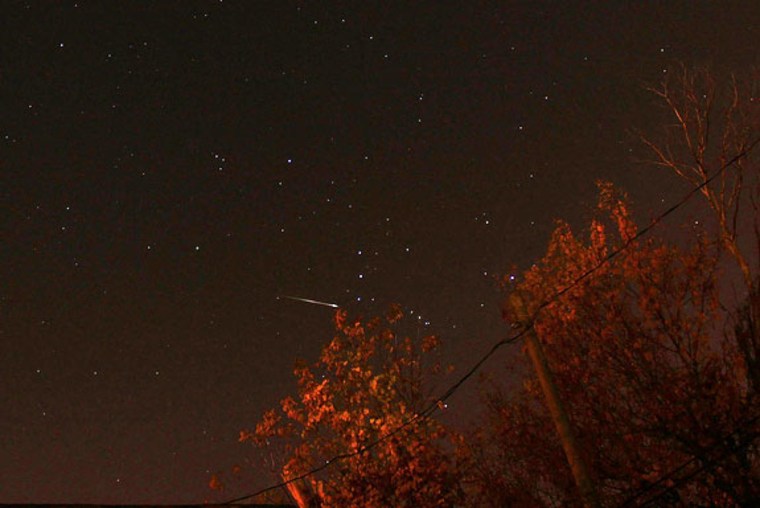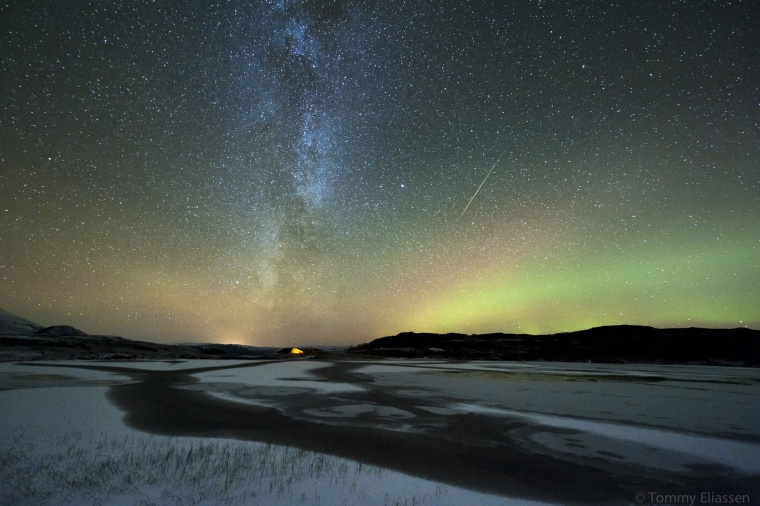The Orionid meteor shower is raining bits of the famed Halley's Comet on Earth this weekend to the delight of stargazers around the world.
The 2012 Orionid meteor shower peaked early Sunday, with forecasters predicting up to 25 meteors an hour for patient stargazers with clear skies well away from city lights. Based on accounts sent into SPACE.com, the meteor shower did not disappoint.
In Norway, photographer Tommy Eliassen captured a spectacular view of the Orionids and Earth's dazzling northern lights.
"An Orionid meteor streaking over the sky, the aurora borealis in the northern horizon and the Milky Way over my camp," Eliassen told SPACE.com in an email from Korgfjellet, Hemnes in Norway. "A very cold but perfect night to photograph the Orionid meteor shower." [Amazing Orionid Meteor Shower Photos of 2012]
In Clinton Township, Mich., observer Dale Mayotte said this year's Orionid meteor display was extra special for him since he finally managed to catch a meteor on camera.

"It only took me about 700 pictures to get this one beautiful meteor, but this is the first one I have ever captured and it happened on my 38th birthday for an EXCELLENT present to myself," Mayotte told SPACE.com in an email. "Sitting in the cold for 2.5 hours was well worth this result."
The Orionid meteor shower occur every October when the Earth passes through a stream of dust left over by Halley's Comet. They appear to radiate out of the well-known constellation Orion, which is why they are called the Orionids.
The meteors flare up in brilliant displays when they streak through Earth's atmosphere at about 65 kilometers per second (that's nearly 150,000 mph), according to NASA astronomer Mitzi Adams.
Adams hosted a live Web chat of the Orionid meteor shower late Saturday and early Sunday from NASA's Marshall Space Flight Center in Huntsville, Ala., where a camera beamed live views of the "shooting stars" display across the Internet.
Adams assured her Web chat audience that there will be Orionid meteors visible in the night sky tonight night and early Monday, just not as many as at the peak time between 3 a.m. and 6 a.m. local time this morning.
The Orionids are one of two meteor showers created by Halley's Comet each year. The Earth passes through a second stream of the comet's debris in May, leading to the Eta Aquarid meteor shower.
The next major meteor shower to light up the night sky will be the annual Leonid meteor shower in mid-November. It will peak on Nov. 17.
Editor's Note: If you snapped any photos of the Orionid meteor shower (or any other amazing night sky sight) and want to share them with SPACE.com, send the pictures, comments and location info to managing editor Tariq Malik at .
You can follow SPACE.com Managing Editor Tariq Malik on Twitter @tariqjmalik and SPACE.com on Twitter @Spacedotcom. We're also on Facebook & Google+.
